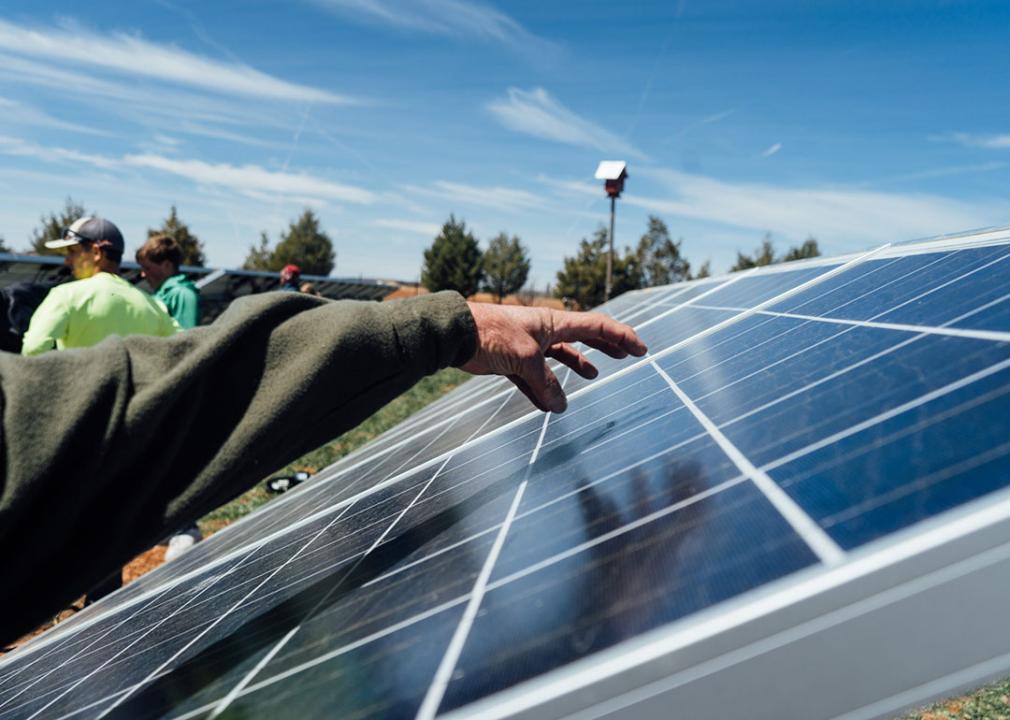New round of federal grants injects billions into rural renewable energy projects

Ilana Newman // Daily Yonder
New round of federal grants injects billions into rural renewable energy projects
A solar panel at Fozzie’s Farm outside of Cortez, Colorado.
A new round of grants from the federal government will pay out $78 million across 12 states and 13 tribal nations, hoping to reduce energy bills for rural people and create new renewable energy projects, the Biden administration announced.
The money will help fund 19 projects in Alaska, Oklahoma, Alabama, Maine and elsewhere, funded by the $1.2 trillion Bipartisan Infrastructure Law signed into law by President Biden in 2021.
The amount of money being pumped into renewable energy sources over the last few years — particularly in rural communities — is “game changing,” said Scott Vlaun, executive director of the Center for an Ecology-Based Economy, one of the grant recipients. In all, the administration set aside $1 billion for its Energy Improvements in Rural or Remote Areas (ERA) program.
“This is huge,” Vlaun said. “When we started our organization 11 years ago there were no opportunities like this to get federal funding for renewable energy projects.”
The projects in this round of funding range from installing new solar installations to running new electrical distribution lines, reports The Daily Yonder. In Washington’s Ferry and Okanogan counties, part of a $5 million grant is dedicated to extending underground electrical lines to about 135-190 homes that will gain access to electrical service for the first time.
In Maine, the Center for an Ecology-Based Economy will receive about $3 million to install small solar projects that will help local families get cheaper electricity and, in some cases, allow families to move away from other, more harmful heating sources like kerosene.
Their power cooperative gives preference to low- to moderate-income households and renters, according to a fact sheet provided by the cooperative. Their panels are also more high-tech than traditional ones — they move throughout the day to follow the sun, increasing the amount of electricity per acre.
A project of less than one acre can power 50 to 80 households, the organization claims. Their panels also allow for other uses in the field, such as growing vegetables or blueberries.
“Between the Bipartisan Infrastructure Law and the Inflation Reduction Act, this is the largest investment in climate action that our government has made by probably many, many fold,” Vlaun said. “This money from the Department of Energy is flowing into rural communities where there’s a heavy energy burden of folks.”
At Mississippi’s East Central Community College, a $2.8 million grant will help pay for solar installations that can provide clean power to 38 campus facilities. That, along with upgrading lighting in about two dozen buildings, should save the college $170,000 annually.
And in the native village of Ouzinkie on Spruce Island, Alaska, $1.7 million will go to construct a solar array and battery to store power during times of bad weather. The Biden administration says that, because there is no grocery store in the village, “modern refrigeration and stable electricity are vital” to protecting the community’s food supply.
The latest round of grants are all between $500,000 and $5 million, and focus on communities with fewer than 10,000 people. Additionally, the administration claims it removed some of the barriers in the application process that have been known to shut out some rural communities.
An analysis last year by the nonprofit Headwaters Economics found that “low-capacity” communities, which tend to be rural, lacked the staff and expertise to compete in previous federal grant competitions, the Yonder reported at the time.
But in communities like those in western Maine serviced by the Center for an Ecology-Based Economy, Vlaun said this round of grants could have a big impact on the everyday lives of many rural residents.
Whether the current enthusiasm to spend federal dollars on renewable energy will continue may depend on the outcome of the November election, he said, and the effectiveness of propaganda aimed at reducing confidence in renewable energy.
“I think there’s a lot of people really worried about what would happen next year if we have an administration change,” he said. “I think we’ve already heard, spread from the source, that they’re going to do everything they can to gut these programs.”
Still, Vlaun said the positive impact of renewable energy projects in rural communities is clear. “We see in our own communities that renewable energy does work, electric vehicles do work, even here in rural Maine,” he said. “But there’s a lot of propaganda out there saying that it doesn’t work, but we see it with our own two eyes that it does work.”
![]()
This story was produced by The Daily Yonder and reviewed and distributed by Stacker Media.
